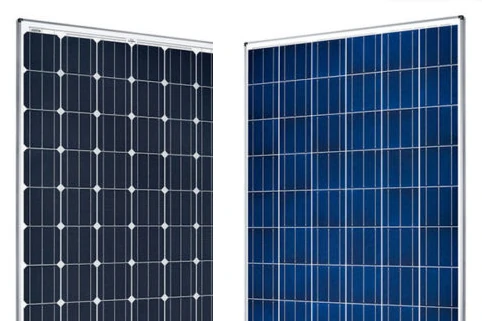Polycrystalline vs Monocrystalline Solar Panels. Easy.
Solar panels are essential components of renewable energy systems, harnessing the power of the sun to generate electricity. When it comes to solar panels, we have two common types: polycrystalline vs monocrystalline. While they serve the same purpose, there are notable differences in their structure and performance. In this article, we will explore the distinctions between polycrystalline and monocrystalline solar panels, helping you understand which might be the right choice for your solar energy needs.

Structure
Polycrystalline Solar Panels: Polycrystalline solar panels are made up of solar cells manufactured with polycrystalline silicon. These cells consist of multiple crystals formed during the cooling process of the molten material. One distinguishing characteristic of polycrystalline panels is their blue or dark blue granular surface.
Monocrystalline Solar Panels: Monocrystalline solar panels are composed of solar cells made with monocrystalline silicon. These cells consist of a single crystal of silicon, extracted as a cylinder or block. Monocrystalline panels are recognized for their uniform black surface and homogeneous appearance.
Efficiency of Polycrystalline and Monocrystalline
Polycrystalline Solar Panels: Generally, polycrystalline solar panels have slightly lower efficiency compared to monocrystalline panels. This means they convert a slightly lower percentage of sunlight into electricity. However, in recent years, the efficiency of polycrystalline panels has improved, narrowing the efficiency gap with monocrystalline panels.
Monocrystalline Solar Panels: Monocrystalline solar panels are known for their slightly higher efficiency compared to polycrystalline panels. They convert a slightly higher percentage of sunlight into electricity. The higher efficiency can be advantageous when space for panel installation is limited.
Polycrystalline vs Monocrystalline: Costs
Polycrystalline Solar Panels: Polycrystalline solar panels tend to be more affordable compared to monocrystalline panels. The production process for polycrystalline solar cells is less complex, contributing to lower production costs.
Monocrystalline Solar Panels: Monocrystalline solar panels tend to have a slightly higher cost compared to polycrystalline panels. The production of monocrystalline solar cells involves a more complex manufacturing process, which incurs additional costs.
Conclusion
Both polycrystalline and monocrystalline solar panels provide excellent sources of renewable and efficient energy for solar power generation. Polycrystalline panels are more cost-effective, while monocrystalline panels offer slightly higher efficiency. The choice between the two depends on specific needs, budget, and installation conditions. Whether you opt for polycrystalline or monocrystalline solar panels, both can contribute to a greener and more sustainable future powered by solar energy.
By the way, heard of Agrivoltaics yet? Find an article here.

